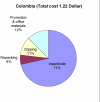Community cooperatives and insecticide-treated materials for malaria control: a new experience in Latin America
- PMID: 12473181
- PMCID: PMC149386
- DOI: 10.1186/1475-2875-1-15
Community cooperatives and insecticide-treated materials for malaria control: a new experience in Latin America
Abstract
Background and objectives: Insecticide-treated materials (ITMs) are effective in substantially reducing the burden of malaria and other vector-borne diseases; but how can high coverage rates of ITMs be achieved and maintained? In south Mexico and on the Pacific and Atlantic coasts of Colombia 14 community-based cooperatives offering three different kinds of ITM services (sale of impregnation services; sale of impregnated nets; production of nets and sale of impregnated nets) were formed and supervised by a national health service (IMSS-SOLIDARIDAD, Mexico) and by an academic institution (the Colombian Institute of Tropical Medicine) along with local district health services. The objectives of this research were to analyse the processes and results of this approach and to identify the favourable and limiting factors.
Methods: The methods used for data collection and analysis were group discussions, individual and semi-structured interviews with users and non-users of ITMs, individual in-depth interviews with cooperative members and supervisors, checks of sales book and observation of impregnation services.
Results: Coverage with unimpregnated nets was above 50% in all study areas. The fastest increase of ITM coverage was achieved through the exclusive sale of impregnation services. Low-cost social marketing techniques were used to increase demand. The large-scale production of nets in two cooperatives was only possible with the aid of an international NGO which ordered impregnated bednets for their target group. A number of favourable and limiting factors relating to the success of ITM cooperatives were identified. Of particular importance for the more successful Mexican cooperatives were: a) support by health services, b) smaller size, c) lesser desire for quick returns and d) lower ITM unit costs.
Conclusions: ITM community cooperatives supported and supervised by the health services have good potential in the Latin American context for achieving and maintaining high impregnation rates.
Figures
Similar articles
-
Unit costs for house spraying and bednet impregnation with residual insecticides in Colombia: a management tool for the control of vector-borne disease.Ann Trop Med Parasitol. 2002 Jun;96(4):405-16. doi: 10.1179/000349802125001159. Ann Trop Med Parasitol. 2002. PMID: 12171622
-
Insecticide-treated materials for malaria control in Latin America: to use or not to use?Trans R Soc Trop Med Hyg. 1999 Nov-Dec;93(6):565-70. doi: 10.1016/s0035-9203(99)90048-2. Trans R Soc Trop Med Hyg. 1999. PMID: 10717733 Clinical Trial.
-
Operational aspects of bednet impregnation for community-based malaria control in Nicaragua, Ecuador, Peru and Colombia.Trop Med Int Health. 1997 Jun;2(6):589-602. doi: 10.1046/j.1365-3156.1997.d01-319.x. Trop Med Int Health. 1997. PMID: 9236827 Clinical Trial.
-
Impregnated bed nets for malaria control: biological success and social responsibility.Am J Trop Med Hyg. 1994;50(6 Suppl):72-81. doi: 10.4269/ajtmh.1994.50.72. Am J Trop Med Hyg. 1994. PMID: 8024087 Review.
-
Insecticide treated nets: impact on vector populations and relevance of initial intensity of transmission and pyrethroid resistance.J Vector Borne Dis. 2003 Mar-Jun;40(1-2):1-8. J Vector Borne Dis. 2003. PMID: 15119065 Review.
Cited by
-
Evaluation of a continuous community-based ITN distribution pilot in Lainya County, South Sudan 2012-2013.Malar J. 2017 Sep 11;16(1):363. doi: 10.1186/s12936-017-2020-8. Malar J. 2017. PMID: 28893263 Free PMC article.
-
Current strategies and successes in engaging women in vector control: a systematic review.BMJ Glob Health. 2018 Jan 7;3(1):e000366. doi: 10.1136/bmjgh-2017-000366. eCollection 2018. BMJ Glob Health. 2018. PMID: 29515913 Free PMC article.
-
Similar cytokine responses and degrees of anemia in patients with Plasmodium falciparum and Plasmodium vivax infections in the Brazilian Amazon region.Clin Vaccine Immunol. 2008 Apr;15(4):650-8. doi: 10.1128/CVI.00475-07. Epub 2008 Feb 6. Clin Vaccine Immunol. 2008. PMID: 18256207 Free PMC article.
-
The costs and effects of a nationwide insecticide-treated net programme: the case of Malawi.Malar J. 2005 May 10;4:22. doi: 10.1186/1475-2875-4-22. Malar J. 2005. PMID: 15885143 Free PMC article.
-
A voluntary use of insecticide treated nets can stop the vector transmission of Chagas disease.PLoS Negl Trop Dis. 2020 Nov 3;14(11):e0008833. doi: 10.1371/journal.pntd.0008833. eCollection 2020 Nov. PLoS Negl Trop Dis. 2020. PMID: 33141850 Free PMC article.
References
-
- Lengeler C. Insecticide-treated bednets and curtains for malaria control (Cochrane Review). The Cochrane Library. Oxford Update Software. 1998. - PubMed
-
- Kroeger A, Mancheno M, Alarcon G, Pesse K : Insecticide-impregnated bednets for Malaria control: Varying experiences from Ecuador, Colombia and Peru concerning acceptability and effectiveness. Am J Trop Med Hyg. 1995;53:313–323. - PubMed
-
- Kroeger A, Gonzalez M, Ordoñez-Gonzalez J. Insecticide-treated materials for malaria control in Latin America: To use or not to use? Trans R Soc Trop Med Hyg. 1999;93:565–570. - PubMed
Publication types
MeSH terms
Substances
LinkOut - more resources
Full Text Sources
Medical



